Constraining the environmental setting and palaeoecology of early animals on the Namibian seafloor
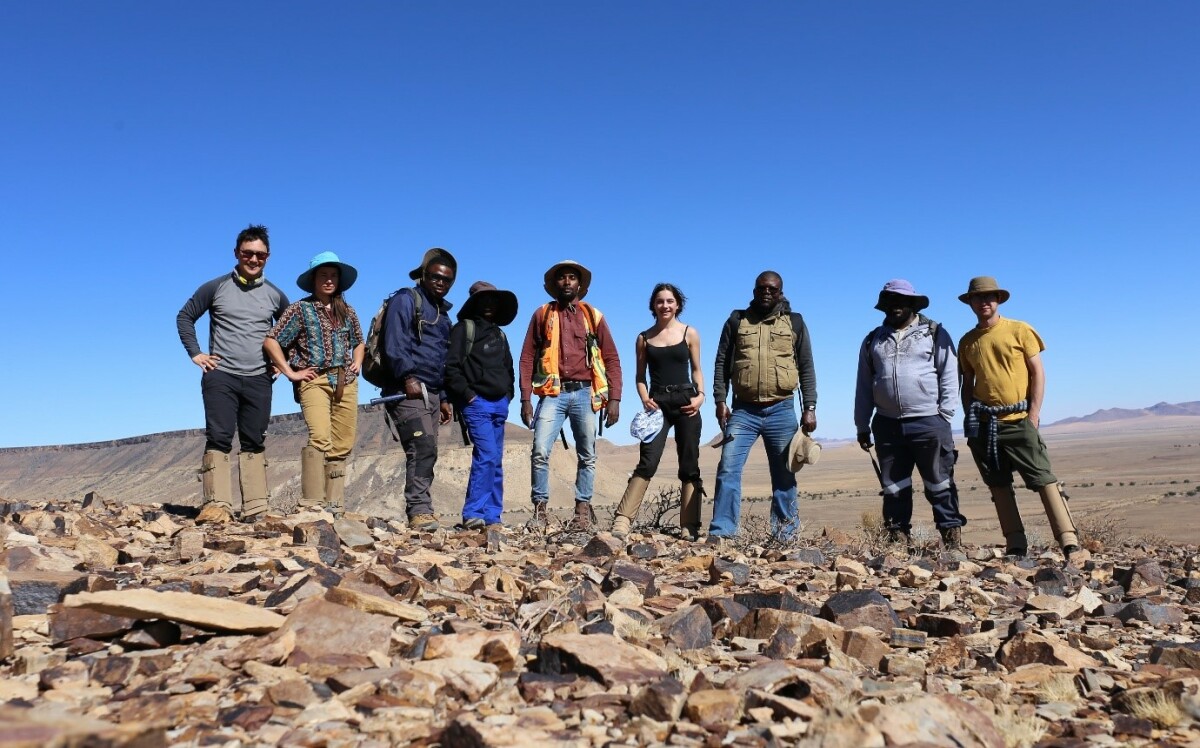
Dr Alex Liu, Dr Collen-Issia Uahengo, and Mr Elkan Utoni
In order to track the evolutionary history of animals back to its earliest beginnings, we must study the fossil record. The oldest fossils of creatures that can be confidently identified as early animals are found in rocks of ~575-540 million years in age, dating to an interval of geological time called the Ediacaran Period. However, these early animals look very different to those that populate our planet today, and it has proven challenging to determine where they fit within the animal tree of life.
One of the world’s best records of Ediacaran fossils can be found amongst the arid, rocky hillsides of southern Namibia. Here, more than 90 years of scientific research has uncovered an array of weird and wonderful fossils that are almost entirely irreconcilable with modern animals. The discovery of a new fossil locality by our team in 2022 offered a remarkable opportunity to study an entirely new suite of fossil taxa – almost all species new to science – that are so well preserved that there is high potential for determining what kind of animals they are. The fossils also uniquely reflect an in situ fossil assemblage (i.e. the organisms are preserved in original life position), allowing us to investigate aspects of their biological interactions and ecology.

Field photograph showing the arid landscapes of southern Namibia. Credit: Alex Liu
Our Cambridge-Africa ALBORADA funded project to document the fossils from this new site involved a four-week field expedition by researchers from the University of Cambridge, University of Namibia (UNAM), University of Edinburgh, and the Geological Survey of Namibia (GSN) in April 2023. We traced loose blocks of the fossil bed back into the hillside, and cleared and excavated a small section. After several days of digging, excavating, cleaning, wrapping and photographing our fossil bed under the unrelenting sun, we successfully transported over 300kg of rocks back to Windhoek, where they will be permanently housed in the GSN museum collections. In Windhoek, UNAM Masters student Mr Elkan Utoni then set to work, undertaking a project that sought to provide a full census of the excavated surface and uncover insights into the ecology of the original organisms.
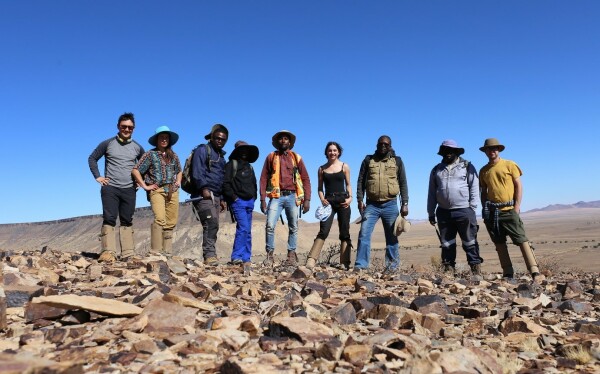
Our 2023 research team, including Alex Liu (far left), Elkan Utoni (centre), and Collen-Issia Uahengo (3rd from right) Image: Alex Liu

The excavation process. Left: excavating and labelling individual blocks. Centre: Cleaning and piecing together the individual blocks to reconstruct the fossil bed. Right: Tracing the surface so that it could be flipped over, to reveal fossil impressions on the underside of the bed. Images: Alex Liu
Our small <2m2 excavated slab yielded over 1000 fossil impressions, immediately indicating that the fossil densities on this surface vastly exceed those seen on any other global bedding plane from the Ediacaran Period. Elkan recognised at least 10 new species, revealing that Namibian Ediacaran fossil assemblages are far more diverse than was previously thought, and then compared the ecology of the surface to that of other well-studied Ediacaran sites around the world. Importantly, the new discoveries challenge narratives that claim a major global mass extinction just prior to the end of the Ediacaran Period, and suggest that the diversification of early animals into the major animal groups we see around us today was a gradual, drawn-out event, rather than an ‘explosive’ burst of evolution.
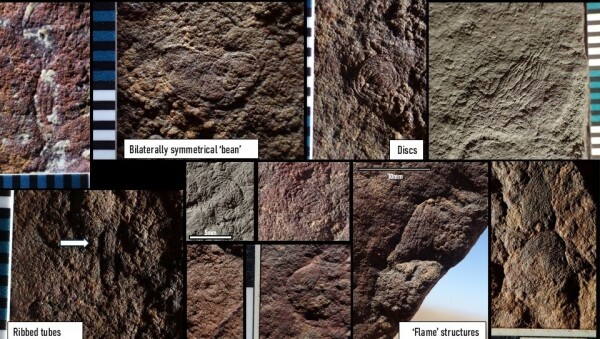
Examples of new fossils from the Namibian fossil bed. All are likely to represent new species. Scale bar increments are in mm and cm. Images: Alex Liu and Elkan Utoni.
Elkan’s thesis on this work was submitted for examination at UNAM in January 2025, and we are jointly writing up his results for publication. A sub-project using loose blocks of the same fossil surface also saw Cambridge undergraduate student Buck Blake conduct a morphospace analysis on the most common type of fossil from the new surface – something we called an annulated tube. Buck demonstrated that these slender, originally flexible organisms are distinct from all existing Ediacaran tubular fossils (of which there are many!), and therefore a genuine new species, which we are jointly writing up for publication.
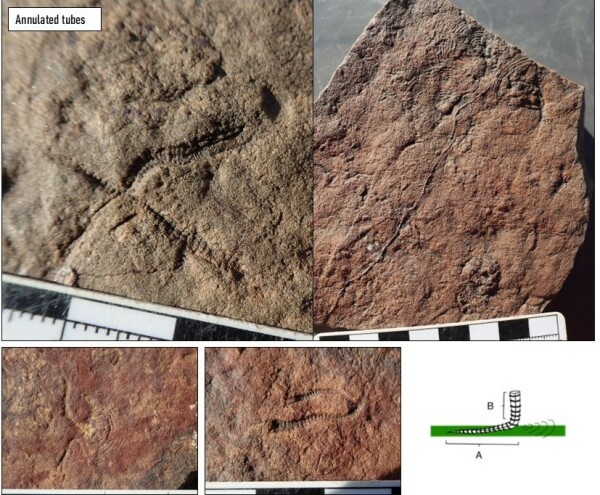
Annulated tube fossils, showing different interactions between the specimens and the surrounding sediment (including ‘scratch circles’, where the tubes have been swung around by a current). Images: Alex Liu and Buck Blake.
The new fossils will reveal much about the origin and early radiation of animals, and will position Namibia firmly at the centre of academic research into this major evolutionary event. Furthermore, the ALBORADA fund enabled us to obtain infrastructure, including cameras, a microscope, and storage cabinets, that has built capacity at UNAM to allow students and researchers to conduct high-quality palaeontological research projects. We intend to continue our collaboration for many years to come, and our intention is for UNAM geoscientists and students to be at the forefront of describing these fascinating new fossils, and celebrating Namibia’s rich geological heritage.
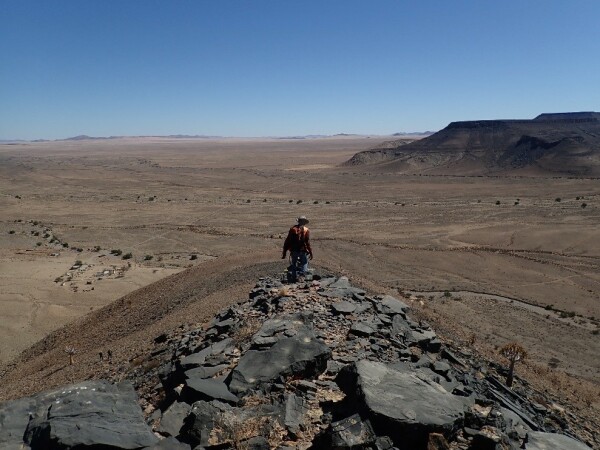
Elkan Utoni searching for fossils, southern Namibia. Image: Alex Liu
Conference presentations:
Utoni, E., Uahengo, C.I., Liu, A.G. et al. September 2023. Spatial Palaeoecological Study of New Bedding Plane Assemblages of the Ediacaran Biota in the Aar Member, Southern Namibia. 29th Colloquium of African Geology (CAG29) conference, Windhoek, Namibia.
Utoni, E., Uahengo, C.I., Liu, A.G. et al. July 2024. Diagenetic impact on porosity and permeability in fossil-rich Aar Member sandstone of the Nama Group, southern Namibia. American Association of Petroleum Geologists Geoscience Technology Workshop (AAPG GTW), Windhoek, Namibia.
Liu, A.G., Utoni, E., Uahengo, C.I. et al. December 2024. New taxa and palaeoecological insights from the latest Ediacaran Aar Member of southern Namibia. Palaeontological Association Annual Meeting, Erlangen, Germany.

